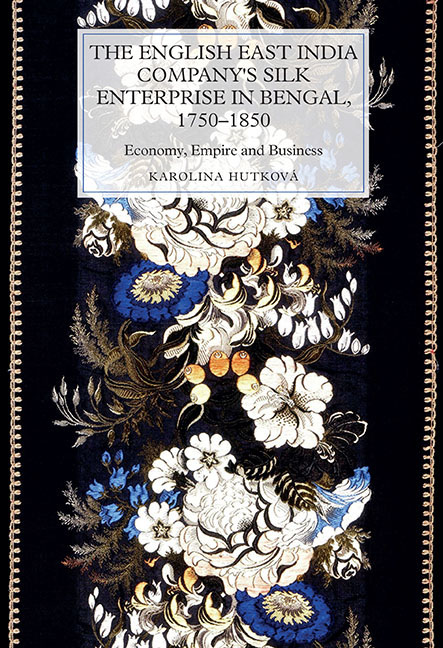Book contents
- Frontmatter
- Contents
- List of Illustrations
- Acknowledgements
- List of Abbreviations
- Measures and Currencies
- Introduction: Companies, Political Economy and the Great Divergenc
- Chapter 1 The Early Modern Silk Industry, Trade and Mercantilism
- Chapter 2 Empire, the English East India Company, and Bengal Raw Silk
- Chapter 3 Bengal, Piedmont and the English East India Company
- Chapter 4 The Bengal Silk Industry and the English East India Company
- Chapter 5 Filatures and Performance in the Bengal Silk Industry
- Chapter 6 The Bengal Silk Industry and British Laissez-Faire Policies
- Chapter 7 Bengal Raw Silk and British Demand in the Nineteenth Century
- Conclusion
- Appendix A Description of the Piedmontese Reeling Machine by Dionysius Lardner
- Appendix B Average Prices of Bengal Raw Silk on the British Market According to the Type of the Silk, 1796–1856
- Appendix C Return on Investment Analysis
- Appendix D Comparison of Manufacturing Costs at the EEIC's Experimental Filature and Common Filature in its Vicinity, 1832
- Appendix E Mechanisation of Silk Throwing and Weaving in England and Scotland, 1856
- Appendix F Types of Silkworm Reared in Bengal Silk Districts, 1818
- Appendix G Glossary
- Bibliography
- Index
- WORLDS OF THE EAST INDIA COMPANY
Chapter 5 - Filatures and Performance in the Bengal Silk Industry
Published online by Cambridge University Press: 31 August 2019
- Frontmatter
- Contents
- List of Illustrations
- Acknowledgements
- List of Abbreviations
- Measures and Currencies
- Introduction: Companies, Political Economy and the Great Divergenc
- Chapter 1 The Early Modern Silk Industry, Trade and Mercantilism
- Chapter 2 Empire, the English East India Company, and Bengal Raw Silk
- Chapter 3 Bengal, Piedmont and the English East India Company
- Chapter 4 The Bengal Silk Industry and the English East India Company
- Chapter 5 Filatures and Performance in the Bengal Silk Industry
- Chapter 6 The Bengal Silk Industry and British Laissez-Faire Policies
- Chapter 7 Bengal Raw Silk and British Demand in the Nineteenth Century
- Conclusion
- Appendix A Description of the Piedmontese Reeling Machine by Dionysius Lardner
- Appendix B Average Prices of Bengal Raw Silk on the British Market According to the Type of the Silk, 1796–1856
- Appendix C Return on Investment Analysis
- Appendix D Comparison of Manufacturing Costs at the EEIC's Experimental Filature and Common Filature in its Vicinity, 1832
- Appendix E Mechanisation of Silk Throwing and Weaving in England and Scotland, 1856
- Appendix F Types of Silkworm Reared in Bengal Silk Districts, 1818
- Appendix G Glossary
- Bibliography
- Index
- WORLDS OF THE EAST INDIA COMPANY
Summary
The transfer of the Piedmontese technologies to Bengal represented a considerable investment. Overall, in the period 1760s–1810s the transfer and adaptation of the Piedmontese system to the Bengal climate cost the Company almost £1 million. Thus, the questions to ask are: was the venture profitable for the Company? If yes, which factors underpin its profitability?
In economic history literature, technology transfers have been assessed from the point of view of factor-price ratios. The scholarship has shown that the similarity of factor prices between the country where a technology originates and the country to which that technology is exported is crucial to profitability in the new environment. India has been labelled as a low-wage economy for which the adoption of a type of factory production in the eighteenth century would be premature. This chapter considers the variation in the prices of labour and inputs between Piedmont and Bengal and shows that the difference, though not insignificant, did not undermine profitability. Control over further stage of raw silk commodity chain was instead the key factor that made the Piedmontese type of silk reeling profitable in Bengal. This enabled the EEIC to build a business model of raw silk production based on adapting the fineness and quantity of raw silk according to demand in Britain, on economies of scale in technology upgrading, and in the long run on learning-by-doing in production and management.
Introduction
Economic history literature frequently cites factor prices as one of the main reasons why India did not adopt a factory system in the eighteenth century and early in the nineteenth century. In the scholarship, centralisation has been mostly related to the rise of factories and the substitution of labour with capital. Centralisation is thus associated with factor-price theories and the discussion of shifts in competitive advantage. Authors such as Stephen Broadberry and Bishnupriya Gupta, E. Rothbarth, Robert Allen, and Yujiro Hayami and Vernon W. Ruttan have focused on how high wages facilitated the development and adoption of capital-intensive technologies associated with high labour productivity. Robert Allen has argued that the Industrial Revolution took place in Britain because it was a high-wage economy and high wages facilitated a search for technologies that could substitute labour with capital. For the cotton industry, Broadberry and Gupta argued that in India comparatively low wages reinforced the focus on labour-intensive domestic cotton production.
- Type
- Chapter
- Information
- The English East India Company's Silk Enterprise in Bengal, 1750–1850Economy, Empire and Business, pp. 119 - 144Publisher: Boydell & BrewerPrint publication year: 2019



